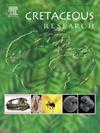巴西东北部早白垩世淡水双壳类:对南美淡水贻贝进化史的洞察
IF 1.7
3区 地球科学
Q1 GEOLOGY
引用次数: 0
摘要
我们对巴西东北部早白垩世(Berriasian - Albian)淡水双壳类进行了修正和描述,包括Unionida、Trigoniida和Sphaeriida的代表。以前被认为是阿普tian到Albian克拉托和Romualdo组,Araripe盆地,cerar本文章由计算机程序翻译,如有差异,请以英文原文为准。
Early Cretaceous freshwater bivalves from northeastern Brazil: Insights into the evolutionary history of South American freshwater mussels
We revise and describe the Early Cretaceous (Berriasian to Albian) freshwater bivalves from northeastern Brazil, including representatives of Unionida, Trigoniida, and potentially Sphaeriida. Three genera previously thought to be endemic to the Aptian to Albian Crato and Romualdo formations, Araripe Basin, Ceará State, i.e. Cratonaia, Araripenaia, and Monginellopsis, are now recorded from other interior basins. The Berriasian to Barremian Mont Serrat Conglomerate (Salvador Formation) of the Recôncavo Basin, Bahia State, hosts a diverse Unionida-dominated fauna, including Mycetopoda, Anodontites?, Cratonaia, and potentially also hyriids. Specimens tentatively assigned to the neomiodontid Musculiopsis also occur. This fauna has mixed Gondwanan and Laurasian affinities and likely thrived in ephemeral streams and/or floodplain lakes. Araripenaia is recorded from the Aptian Marizal Formation of the Tucano Basin. Supposed representatives of Sphaerium from the same strata are clam shrimps (Diplostraca). Cratonaia and Monginellopsis occur in the Aptian-Albian Itapecuru Formation of the Parnaíba Basin, Maranhão State. Articulated shells of Cratonaia, Araripenaia, and Monginellopsis are typically associated with fluvial-lacustrine deposits. Their common occurrence in Aptian-Albian strata of northeastern Brazil suggests dispersal via fluvial systems connecting the different sedimentary basins. These northeastern Brazilian assemblages are distinct from those of the Upper Cretaceous Bauru Basin in southeastern Brazil. Despite South America and North Africa being connected for most of the Early Cretaceous, no shared freshwater bivalves are known. The newly described faunas provide insight into South American Early Cretaceous freshwater mussel diversity when the proto-South Atlantic was dominated by alluvial and lacustrine settings hosting abundant but poorly known freshwater bivalves.
求助全文
通过发布文献求助,成功后即可免费获取论文全文。
去求助
来源期刊

Cretaceous Research
地学-地质学
CiteScore
4.10
自引率
19.00%
发文量
235
审稿时长
12 weeks
期刊介绍:
Cretaceous Research provides a forum for the rapid publication of research on all aspects of the Cretaceous Period, including its boundaries with the Jurassic and Palaeogene. Authoritative papers reporting detailed investigations of Cretaceous stratigraphy and palaeontology, studies of regional geology, and reviews of recently published books are complemented by short communications of significant new findings.
Papers submitted to Cretaceous Research should place the research in a broad context, with emphasis placed towards our better understanding of the Cretaceous, that are therefore of interest to the diverse, international readership of the journal. Full length papers that focus solely on a local theme or area will not be accepted for publication; authors of short communications are encouraged to discuss how their findings are of relevance to the Cretaceous on a broad scale.
Research Areas include:
• Regional geology
• Stratigraphy and palaeontology
• Palaeobiology
• Palaeobiogeography
• Palaeoceanography
• Palaeoclimatology
• Evolutionary Palaeoecology
• Geochronology
• Global events.
 求助内容:
求助内容: 应助结果提醒方式:
应助结果提醒方式:


